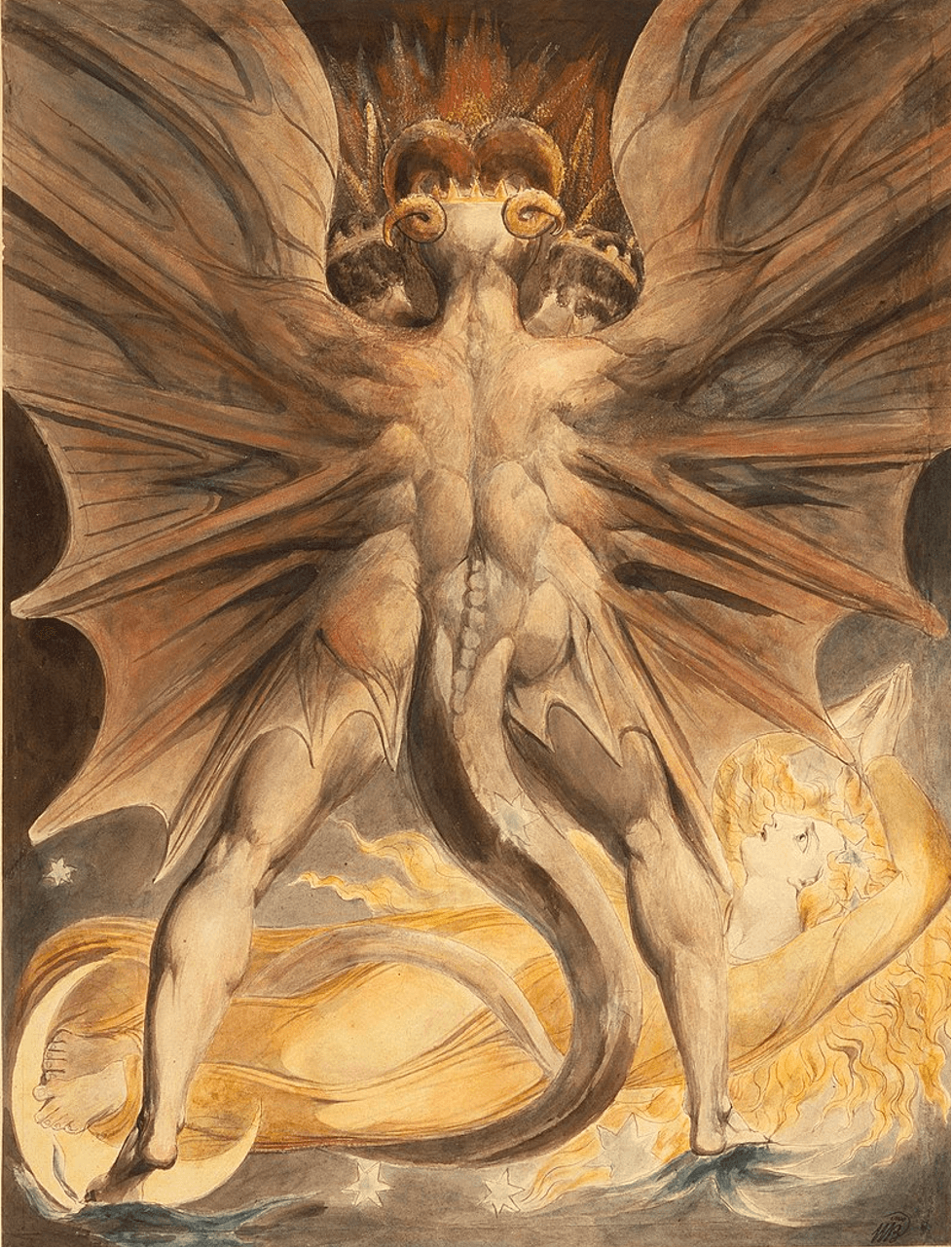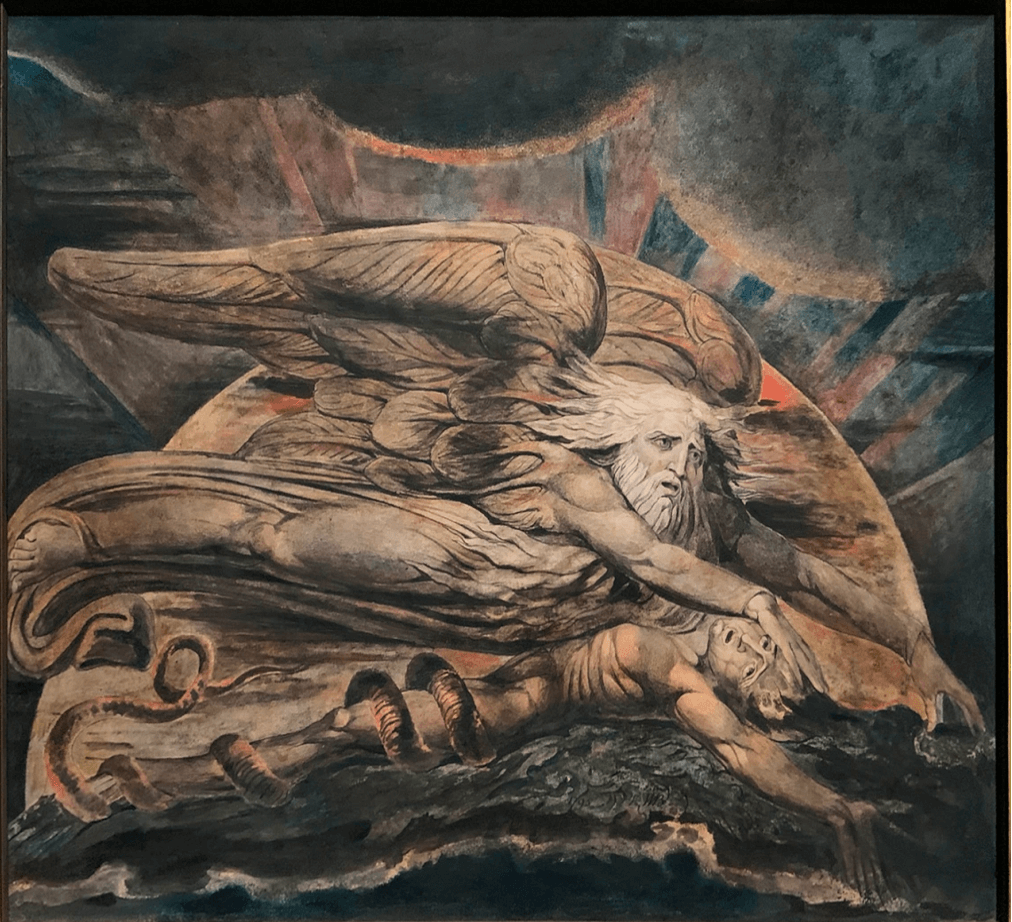Archetypal chaos of creation and destruction
by Sousan Qadeer

William Blake, The Great Red Dragon and the Woman Clothed in Sun, c. 1803-1805. Brooklyn Museum.
Destruction stands there, emanating paramount strength and power from every part of his being, spanning its great bat-like wings. It stands on top of the woman, who begs for life, not of her own but of her unborn child; a symbol of hope for the stranded souls. But the dragon wants to devour the child yet to be born. In this way, he not only extinguishes the hope for all of mankind but also exacts his revenge for his exile from the Garden. But just before having his finger licking delicious meal, he mimics the crucifix. Not sure if to tease the poor woman who is already in distress by the labour pains or God Himself. But this crucifix does not represent the redemption or the resurrection, however the inversion of the cross symbolises the destruction that the dragon will bring upon humankind once it's done swallowing the child. He wears the crown of red horns on his head declaring himself as an exalted king who rests hell on his head. He sweeps the woman in the air by flapping his unholy wings in the night, standing on top of a dark flood which he has brought forth with him to engulf the woman in its destruction. He binds the woman with his enormous tail so as to not let her escape. The woman watches the dragon above in horror while praying to the God who might not be there to rescue her. If the woman embodies the Sun then the dragon is the gigantic moth which wants to devour its light. He is the Icarus that in fact devoured the Sun just because he was strong enough to do so. And the Sun is in his feet, so are the constellations and the moon. All hope lies dead beneath him and the dragon rejoices. Even though his faces are not visible, the joy is evident with the way he stands in perfect symmetry. With birth comes death, which is the balance of life and this is exactly what the dragon represents. The mirroring of the dragon’s wings represents the duality of the archetypes of chaos and order. Both are dependent on each other for their survival. It is the perpetual fight between the good and evil which was foretold in the Book of Revelation, as a sign of warning for the good Christains for keeping faith in testing times or else the dragon will take over. The dragon has been in opposition to the woman throughout history. Though he has changed into various forms, his conflict with the woman has not changed. He is the bringer of destruction and spoils harmony. Sometimes he comes to the woman in the shape of a serpent offering her forbidden fruit. At other times and in strange places, he embodies Ravana (also with multiple faces) abducts Sita and makes her walk on fire. The dragon represents the looming shadow of death on a calm Tuesday afternoon. He represents the destruction which is mandatory for the eternal flow of life. This destruction is the end of the old and beginning of the new cycle. Most importantly, he represents the fire that is needed for the survival of all species is also necessary to burn everything down to ashes. He embodies Satan, without whom the noble deeds of the prophets would not be appreciated for there would not be any soul worth saving.

William Blake, Elohim Creating Adam, 1795 – c. 1805, color print, ink and watercolor on paper. Tate Museum, London.
If the creative process is an excruciatingly exhausting thing then there is no better way to illustrate this pain than the facial expressions of Elohim as he creates Adam from the primeval earth. He rests his right hand on Adam’s head and his left hand on the earth as if taking inspiration from the soil’s composition and literally making man out of clay. Beneath the primeval earth, some part of the chaotic sea is visible. It is the life after the flood that is spurting out of the remains of the destruction. A new but bleak sun rises in the background symbolizing the possibility of hope in the time of despair. And its rays mimic the bat-like wings of the red dragon. Perhaps it adumbrated the future fall of newly born Adam, who is rather preoccupied at that moment and oblivious to his demise which is yet to come. The facial expressions of both Elohim and Adam are congruent with each other as of a mother and her child who both cry at the moment of birth. Adam, much like a newly born babe, finds himself tricked at the hands of his Father. Having been brought into this perfidious world against his will. He is not completely out of his placenta that he finds himself with a serpent coiled around his leg. Reminding him of eternal battle that he will be fighting with himself. Though Elohim created Adam in his image, yet he does not give him His wings, which also suggests Elohim as the predetermining force behind Adam’s fate. As if he wants Adam to fall from grace, just as birds push their chicks out of their nests when they are done fetching from them, except Adam has not been provided with a pair of wings which he would have used. As if Elohim has intentionally binded that serpent with Adam’s leg and has sealed his destiny. Because this is the archetypal father that you get in the Old Testament: rigid, controlling and selfish unlike the archetypal father of the New Testament with a more positive connotation, who would rather sacrifice himself for the greater good of mankind. But Adam doesn't care for all that as he lies beneath his Father unknowingly, with his ribs exposed, as to whenever he trades one of them for his beloved Eve, the serpent will hiss words of wisdom unto Her which will be the cause of the great fall. Even in the act of creation, the image is laden with the predestined devastation of Adam, solidifying the idea of the archetypal creation and destruction and the spindle on which they spin, waiting for someone to prick their finger from it and down they go into the rabbit’s hole of chaos.
But however depressed they both seem at this creation, there is still hope for a better creation to take place by the hands of a much more considerate God of the New Testament who can spark life only with a touch of his finger into a much relaxed Adam. The latter creation of Adam can be called a surrogacy in comparison to the former creation of how relaxed the facial expressions are of both parties. This God is not an oppressor like Elohim but rather an ideal or a concept. Elohim’s Adam lies in crucifix position heralding that one day he will be replaced by Jesus, who will later be resurrected, coming full circle with the operation of destruction and creation. Even though the subject matter in both images might differ from each other in terms of the archetypes of order and chaos, as the red dragon represents destruction (in the Jungian sense, represents the obstacles in your life. The things that make your life harder and yet push you towards self actualization) and Adam signifies creation, they both depict the same thing which is the agonizing procedure of transformation. Adam has been transformed into a man from clay or maybe from some beast as his hooves are still visible where his feet are supposed to be. Perhaps it is alluding to the mortality of the human kind as it is of all the life on this planet or it might be a hint to the evolution of the humankind as a species which has been created from a seed as all life on earth have been created. Whereas, the transformation of the red dragon is not much simpler than Adam’s transformation. The changing of beast to man denotes prospects of civilization but the transformation of man to beast might suggest something much more sinister. The dragon represents the shadow which is constantly repressed by the ego. Evil and menace that had been fed to it have made the shadow so enormous that now it has become a person of its own. The dragon is in its prime and there is not any hero in sight who will be able to slay it.